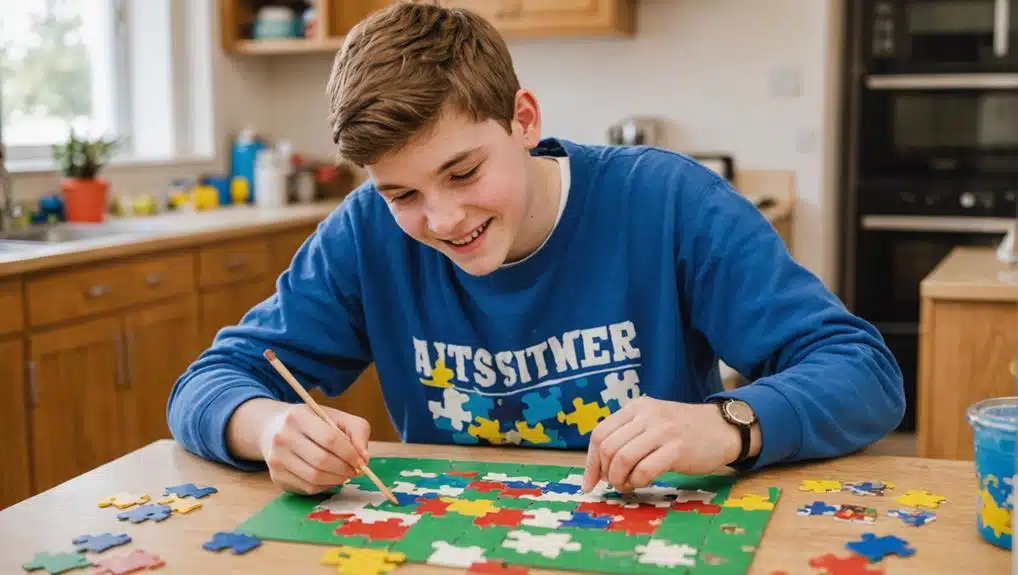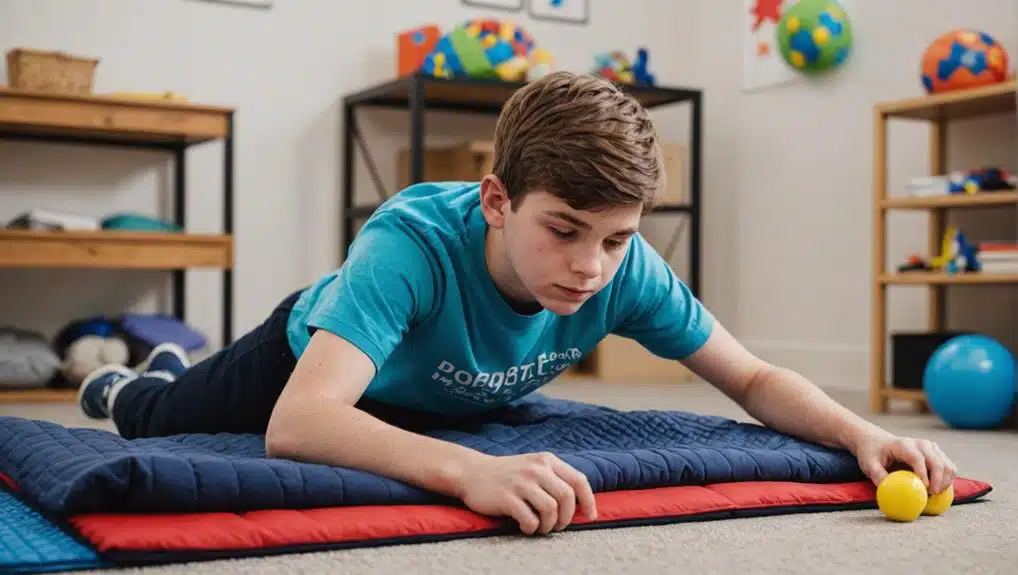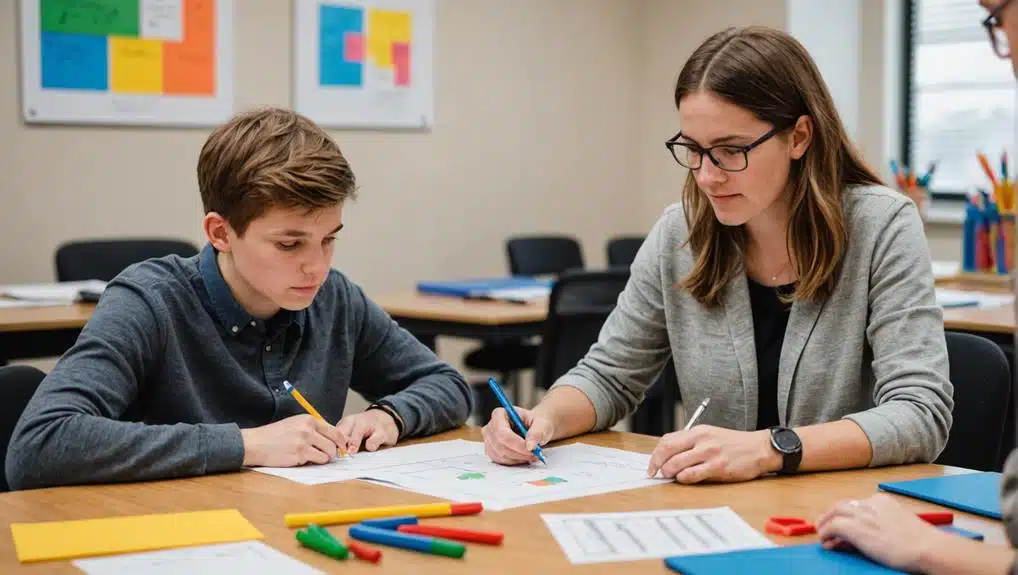The impact of Pediatric Occupational Therapy (OT) in fostering independence among autistic teenagers is a significant yet often overlooked subject. By focusing on improving daily life skills, enhancing social interactions, and managing sensory issues, OT provides a pathway for these teens to gain autonomy. But how does this process work? What strategies are employed, and how effective are they? These questions create a compelling exploration into the world of occupational therapy and its role in the pathway toward independence for teens with autism.
Key Takeaways
- Occupational therapy for teens with autism focuses on promoting independence by enhancing daily activities and social skills.
- Therapists design personalized interventions to develop essential life skills, considering each teen’s unique needs.
- Techniques such as role-playing and group activities boost social interactions and emotional regulation.
- Sensory integration practices in occupational therapy help teens with autism manage daily stimuli and reduce anxiety.
- Occupational therapy fosters autonomy in teenagers with autism by teaching them to break down and manage daily tasks effectively.
Understanding Autism Spectrum Disorder
One must grasp the complexities of Autism Spectrum Disorder (ASD) to understand its impact on adolescents fully. ASD is a developmental condition characterized by challenges in social interaction, communication, and repetitive behaviors. Practical approaches such as ABA therapy and consistent parental support can improve these areas. These issues often result in difficulties in daily living, self-regulation, and social participation, especially in adolescence.
Facing these challenges, adolescents with ASD require tailored interventions to meet their specific needs effectively. A one-size-fits-all approach will not suffice. Instead, a thorough understanding of each person’s strengths and weaknesses is necessary to develop targeted strategies to promote daily independence and functionality.
However, addressing the diverse manifestations of autism spectrum disorder calls for a holistic approach that encompasses physical, cognitive, and sentimental well-being. This all-encompassing perspective takes into account the multifaceted nature of ASD, acknowledging that the patient’s experience is distinct. It also underscores the importance of empathy and understanding in delivering care.
Ultimately, understanding ASD is the initial step in serving adolescents with the disorder. With grasp and empathy, we can create effective interventions that will help these young individuals navigate the challenges of their daily lives.
The Role of Occupational Therapy
Having gained a thorough understanding of Autism Spectrum Disorder and its impact on adolescents, we can now examine a critical intervention that supports these individuals: Occupational Therapy. This therapy plays a vital role in promoting independence among autistic teens by focusing on skill development in daily activities, thereby enhancing their quality of life.
Occupational therapists work diligently to cultivate necessary skills in these teens, such as self-care, social interaction, and problem-solving abilities. These capabilities are vital in helping them navigate the often challenging terrains of school, social situations, and emotional regulation. They also coordinate with professionals like BCBAs, SLPs, educators, and psychologists to provide tailored plans for the teen’s needs and strengths.
One of occupational therapy’s hallmarks is the provision of personalized interventions. These are designed to meet each teen’s needs, considering their unique goals, strengths, and areas of challenge. This customized approach, a significant part of holistic and personalized autism care, ensures that each teen experiences the full benefits of the therapy rather than a one-size-fits-all method.
Through this holistic approach, occupational therapy empowers autistic teens to build essential life skills. These skills are crucial for their independence and success in various aspects of life.
Benefits of Occupational Therapy

Occupational therapy offers concrete benefits for teens with autism, especially in the areas of daily activities and social interaction. By promoting independence in routine tasks, this therapeutic approach can significantly improve their quality of life. Pediatric OT specifically concentrates on cultivating the necessary skills for daily tasks, boosting self-assurance and independence. Moreover, it offers efficient strategies to enhance social skills, assisting their integration into different social environments.
Enhancing Daily Activities
Improving daily activities is a vital aspect of occupational therapy for teens with autism. This therapeutic approach fosters independence by developing essential life skills for daily tasks such as self-care, meal preparation, and organization.
A significant part of this therapy is enhancing sensory processing, which can often be a challenge for individuals with autism. By addressing these sensory needs, teens can better cope with daily stimuli, making tasks such as meal preparation or personal hygiene less overwhelming.
These customized interventions break down each task into manageable steps, allowing for gradual skill acquisition. For example, a teen might learn meal preparation by mastering basic tasks such as washing vegetables or operating a microwave before progressing to more intricate activities such as cooking a full meal. Similarly, self-care skills might start with fundamental hygiene habits before advancing to tasks like managing personal belongings or organizing a schedule.
Occupational therapists provide compassionate guidance throughout this process, supporting teens as they navigate the challenges and celebrate the successes of becoming more self-sufficient. The ultimate goal is to enable autistic teens to take charge of their daily activities, fostering a sense of independence that will serve them well into adulthood.
Promoting Social Skills
Traversing the intricate world of social interactions can often be a challenging labyrinth for teens with autism. Occupational therapy offers a structured intervention pathway that aids these teens in finding their way through this intricate terrain. Through a multidisciplinary approach, occupational therapy integrates diverse techniques for promoting social skills, focusing on improving communication, emotional regulation, and social interaction in autistic teens.
These benefits are achieved through various methods, such as role-playing, group activities, and targeted exercises. Each activity is carefully crafted to facilitate the effective practice of social skills.
In the nurturing environment of occupational therapy, teens with autism can improve their communication abilities, empathy, and social reciprocity. These skills are essential for successful social interactions, allowing these teens to better connect with the world around them. The structured interventions provided by occupational therapy are advantageous and fundamental to developing these essential social skills. Essentially, occupational therapy offers a guide to help autistic teens through the often challenging labyrinth of social interactions.
Occupational Therapy Interventions
Occupational therapy interventions for autistic teenagers focus on fostering self-reliance in daily activities. These interventions aim to develop crucial skills, enrich social interaction, and manage sensory issues, all contributing to increased autonomy.
Occupational therapy interventions are tailored to meet the distinct needs of each teenager. They target key areas such as self-care, social skills, sensory processing, and fine motor skills. This personalized approach ensures that therapy is relevant, practical, and beneficial, explicitly addressing the challenges faced by each teen.
One of the most significant aspects of these interventions is using evidence-based strategies. These strategies have been proven effective in improving the abilities of teens with autism in different functional areas. By implementing these techniques, therapists can profoundly impact the teens’ ability to perform daily tasks, interact socially, and process sensory information.
The ultimate goal of occupational therapy interventions is to enable teenagers with autism to lead more independent and fulfilling lives. It is about acquiring and using skills to achieve higher autonomy and improved quality of life. This is the core of occupational therapy interventions for teenagers with autism.
Activities for Skill Development

Occupational therapy for teens with autism often encompasses activities that nurture skill development. These activities, ranging from play-based learning to tasks promoting daily life skills, are designed to boost the teen’s independence and self-efficacy. By strategically implementing these activities, therapists can effectively support the teen’s progression to autonomy.
Play-Based Learning Benefits
In occupational therapy, play-based learning greatly helps autistic teens gain essential life skills. This therapeutic approach involves engaging learners in enjoyable activities that foster communication, social interaction, problem-solving, and motor coordination skills. Play-based activities utilize toys, games, puzzles, and interactive tasks to improve daily activity performance and promote independence, thus preparing these young individuals for a self-reliant future.
One such activity involves creating obstacle courses promoting gross motor skill development. These exercises significantly improve the learner’s physical coordination by encouraging jumping, climbing, crawling, and balancing. Similarly, cooking sessions in therapy provide an opportunity for sensory exploration and fine motor skills development. Stirring, measuring, and handling cooking utensils enhance coordination and grasp, all while promoting social interaction and communication.
Furthermore, social skills building is a critical component of play-based learning. Through video-based interventions, social stories, and peer interaction groups, teens with autism can improve their understanding of emotions, develop perspective-taking, and learn appropriate responses. Thus, play-based learning in occupational therapy offers an engaging, effective, and comprehensive approach to skill development for teens with autism.
Promoting Daily Life Skills
Promoting independence in daily life skills is a cornerstone of occupational therapy for teens with autism. These crucial skills include self-care tasks, meal preparation, organization, and hygiene. Therapists design activities to enhance these skills, broken down into manageable steps to support their developmental process.
This approach aims to build vital life skills contributing to autonomy and self-sufficiency. In a world that often feels chaotic or confusing, the ability to manage daily tasks independently can increase a teen’s self-esteem and sense of control.
Tailored interventions are a critical part of this process. Every teen with autism is distinct, with their strengths, challenges, and interests. Occupational therapists recognize this diversity and adjust their approaches accordingly. They might use visual aids for a teen who thinks in images or break tasks down into smaller steps for someone who struggles with executive functioning.
The end goal is always the same: to help teens with autism achieve greater independence in their daily tasks. Focusing on practical, everyday skills gives them the tools to navigate the world independently.
Enhancing Social Interactions
Fostering social connections for teens with autism is a core focus of occupational therapy. This approach emphasizes improving social interactions and communication skills, which is essential as it strengthens these teens’ ability to maneuver the social dynamics around them.
Structured interventions like role-playing and group activities are fundamental to this therapeutic approach. These strategies provide a supportive environment for teens with autism to practice communication, empathy, and social reciprocity. These settings not only nurture improved social engagement but also strengthen peer relationships.
In this scenario, occupational therapy aims to boost overall social functioning. By helping teens with autism understand and respond appropriately to social cues, therapists enable them to build meaningful connections within their communities. This understanding aids in navigating the intricate social dynamics they encounter in everyday life.
Occupational therapy plays a significant role in helping autistic teens lead more fulfilling lives. By improving social interactions and communication skills, therapists can help these teens enjoy a higher quality of life and become successful, independent adults.
Sensory Integration Techniques

Sensory integration practices are crucial in occupational therapy for autistic teenagers as part of the therapeutic toolkit. These specialized approaches aid individuals in regulating and processing sensory details effectively, reducing anxiety, enhancing attention, and promoting self-control in daily activities.
Occupational therapists skillfully offer personalized sensory experiences, addressing the distinct sensory processing challenges often faced in autism. These structured sensory integration practices promote successful task engagement, making everyday interactions less overwhelming and more attainable for these teenagers.
Sensory integration goes beyond the scope of individual tasks, positively impacting broader aspects of life. It contributes to improved social interactions, boosting teenagers’ abilities to understand and respond to the sensory signals that underlie human communication. Moreover, it strengthens emotional regulation, equipping individuals with autism better to handle their responses to the sensory-rich world around them.
Incorporating sensory integration practices in occupational therapy is not just about addressing a single aspect of autism. It’s about improving the overall well-being of teenagers with autism, enabling them with the tools to navigate their world more confidently and autonomously.
Fostering Independence in Daily Life
Building on the foundations laid by sensory integration techniques, occupational therapy for adolescents with autism further extends its scope to strengthen self-reliance in everyday life. This type of therapy promotes autonomy in daily activities by tailoring interventions to improve crucial life skills. These interventions are designed to break down tasks into manageable steps, increasing the likelihood of a successful outcome.
Occupational therapy empowers adolescents with autism to participate fully in their lives. This approach is not just about teaching skills but also about instilling confidence in their abilities. The following are four key ways occupational therapy fosters independence in daily life:
- Personalized Approach: Therapists customize strategies based on each adolescent’s needs and abilities, ensuring that interventions are relevant and practical.
- Skill Improvement: The therapy focuses on vital life skills such as self-care, organization, and meal preparation.
- Task Breakdown: Tasks are divided into smaller, manageable steps to enable adolescents to master each part gradually.
- Guidance and Assistance: Therapists provide continuous guidance and support, helping adolescents to progress towards greater independence.
With these tailored interventions, occupational therapy plays a crucial role in fostering independence in adolescents with autism.
Assessment and Goal Setting

An initial assessment is a critical initial step in occupational therapy for teens with autism. This process involves observations, interviews, and formal evaluations to identify areas where the teenager may need support. From these findings, the therapist and family collaborate to set realistic, personalized goals, which guide future intervention sessions and focus on fostering independence.
Initial Assessment Process
Initial evaluation in occupational therapy for adolescents with autism is a cooperative and multifaceted effort. Developing a multidimensional understanding of the teen’s abilities, challenges, interests, and environment is critical. This process involves much more than simply identifying skill development gaps. It requires active collaboration between the therapist, the teen, and their family to develop individualized goals that align with their needs and aspirations.
In detail, the initial evaluation process follows these key steps:
- Gathering relevant information about the teen’s developmental history, daily routines, and previous interventions through discussions with the family and review of available records.
- They observe the teen in different settings (e.g., home, school, community) to understand their abilities, challenges, and interactions with their surroundings.
- We are conducting formal evaluations to identify the teen’s sensory processing, motor skills, social-emotional abilities, and cognitive functions.
- Based on the evaluation findings, we are collaborating with the teen and family to establish attainable and significant goals.
This cooperative and individualized approach ensures that the therapy plan is customized to support the teen toward independence and enhanced quality of life.
Setting Achievable Goals
In an ideal therapeutic setting, the collaborative efforts between occupational therapists and families of teens with autism are crucial to establishing attainable goals. This process begins with a thorough assessment, utilizing methods such as observation, interviews, and formal assessments to identify gaps in skill development. The identified gaps are a foundation for establishing specific, measurable goals that align with the teen’s needs and aspirations.
Goal setting is not a unilateral decision by the therapist but a shared responsibility involving the family and, where possible, the teen. The initial sessions focus on developing a plan and outlining the skills necessary to achieve the set goals. This approach guarantees the goals are attainable, relevant, and meaningful to the teen.
Establishing attainable goals in occupational therapy is essential in paving the way for teens with autism to progress toward greater independence. The goals serve as stepping stones, enabling the teen to experience success, which motivates further skill development. In this way, occupational therapy allows teens with autism to take control of their lives, fostering autonomy and enhancing their capacity to contribute meaningfully to their communities.
Strategies for Skill Development
Armed with various practical methods, occupational therapists utilize modeling and prompting techniques to impart specific skills to adolescents with autism. These OT interventions are crucial in skill development, aiding adolescents in grasping essential abilities and enhancing their autonomy.
Environmental adjustments are often implemented to promote focus and attention during these sessions. Changes may involve alterations in lighting, seating, or elimination of potential distractions. Personalized strategies, such as breaking activities into manageable steps, support tailored learning paces and capabilities.
To highlight the significance of OT interventions in skill development, consider the following:
- Modeling and Prompting Techniques: These methods enable therapists to demonstrate and guide adolescents through tasks, effectively teaching new skills.
- Environmental Modifications: These adaptations create a conducive learning environment, reducing distractions and improving focus.
- Personalized Strategies: Tailored approaches cater to specific needs, making skill acquisition feasible and efficient.
- Promotion of Independence: Occupational therapy nurtures a sense of self-reliance and autonomy by equipping adolescents with the necessary skills for daily tasks.
With these strategies, occupational therapy plays a significant role in nurturing the growth and development of adolescents with autism.
Parental Involvement in Therapy

Indeed, the collaboration between parents and therapists plays a vital role in the success of occupational therapy for adolescents with autism. Their partnership is crucial in establishing achievable goals and monitoring progress towards autonomy. Parents, as the primary caregivers spending the most time with their teenagers, offer valuable insights into their strengths, challenges, and preferences, enabling the development of tailored interventions.
Participation in therapy sessions equips parents with the knowledge and strategies needed to support their teenagers’ progression toward independence. This teamwork enables them to consistently apply these strategies at home, strengthening the impact of therapy and nurturing a supportive atmosphere for skill enhancement.
Parental engagement in occupational therapy surpasses mere involvement. It signifies a dedication to understanding their teenager’s specific requirements, an investment in their development, and a pathway to fostering their self-reliance. This active participation and professional guidance establish a synergy that propels autistic adolescents towards an autonomous and rewarding life. Involving parents in therapy is advantageous—it’s crucial to the therapeutic process and achieving its objectives.
Transitioning to Adulthood
The path toward adulthood for teens with autism is a significant phase marked by the preparation for independent living, employment, and further education. During this progression, personalized support and interventions are crucial. Occupational therapy plays a pivotal role in this process, focusing on enabling these teens to navigate the complexities of adulthood and achieve personal goals.
In the context of moving toward adulthood, occupational therapy for teens with autism includes:
- Building Independence: Cultivating skills for daily living, making decisions, and solving problems.
- Vocational Training: Preparing teens for employment through job training and workplace etiquette education.
- Social Integration: Enhancing abilities to interact effectively with peers and participate in community activities.
- Tailored Support: Providing individualized strategies and interventions that address each teen’s needs and challenges.
These components aim to develop self-advocacy and community integration skills necessary to live independently. By offering these specialized services, occupational therapists champion the progression toward independence for teens with autism, facilitating a smoother and more successful journey to adulthood.
Frequently Asked Questions
How Do You Promote Independence in Autism?
Promoting independence in people with autism involves creating structured environments, breaking down tasks into manageable steps, consistent practice, and providing support as they acquire crucial life skills for daily living and social interaction.
Why Do Autistic People Struggle With Independence?
Autistic people often struggle with autonomy due to challenges in executive functioning, sensory sensitivities, social interaction difficulties, shifts between activities, and limited fine motor skills, impacting their ability to perform daily tasks independently.
How to Live Independently With Autism?
Living independently with autism involves mastering daily tasks such as cooking, cleaning, and budgeting. Occupational therapy can offer strategies and interventions to support this process, promoting self-sufficiency and enhancing quality of life.
How Do Occupational Therapists Promote Independence?
Occupational therapists foster independence in autistic teens by enhancing daily living skills, fine and gross motor abilities, social interactions, and sensory integration enabling effective navigation in daily activities and social situations.
Conclusion
To summarize, it is essential to highlight that around one in every 68 children is diagnosed with Autism Spectrum Disorder. Through tailored interventions, occupational therapy dramatically improves these teens’ daily living skills, social interactions, and sensory processing abilities. This therapeutic approach nurtures their independence, autonomy, and general well-being, preparing them for a successful shift to adulthood. It is essential to recognize parents’ significant role in this process, offering support and reinforcing therapy strategies at home.


Recent Comments